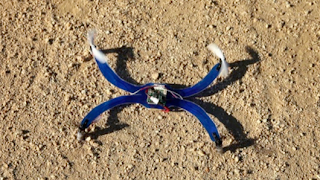

Quick Caps made to thwart bicycle wheel thieves
By Ben Coxworth September 29, 2014
Quick Caps make it impossible to pull open a bike's quick-release wheel levers – without the key
While quick-release hubs certainly make it easier for cyclists to remove and reinstall their wheels when doing things like fixing flats, they also make it very easy to steal those same wheels. As a result, riders typically have to remove the front wheel when locking up their bike, or run a secondary cable lock from it to the main U-lock. Quick Caps, however, are designed to make doing so unnecessary – they're little padlocks for the quick-release levers.
Quick caps also work on mountain bikes Each Quick Cap consists of a weatherproof anodized marine-grade aluminum locking body, and...A pledge of £10 (about US$16) will get you one, with £19 ($31) required for a pair – assum...
Created by British engineer Curtis Dorrington, each Quick Cap consists of a weatherproof anodized marine-grade aluminum locking body, and a hardened steel shackle. To use them, you just slip the body over the bike's quick-release lever, put the shackle around the cylindrical base of that release, then slide the shackle into the body and lock them together.
Once in place, the locked Quick Cap will make it impossible to pull open the lever ... until it's unlocked with the user's key. Should thieves instead try simply unscrewing the lever from the hub axle, a protruding section on the underside of the locking body will catch against the fork/drop-out, keeping the lever from rotating.
Each Quick Cap consists of a weatherproof anodized marine-grade aluminum locking body, and...
According to Dorrington, each Quick Cap weighs 51 grams, and it takes approximately 900 Nm (664 ft lb) of force to break them. He's currently raising production funds, on Kickstarter. A pledge of £10 (about US$16) will get you one, with £19 ($31) required for a pair – assuming the funding goal is met. You can see a product demo in the pitch video below.
Other recent approaches to making quick-release wheels theft-proof include the Sphyke C3N system, which replaces the levers with mini combination locks; infiniti3D, which replaces them with a key lock; and Pinhead, which only unlocks with the use of a product-specific tool.
Sources: Quick Caps, Kickstarter
http://www.quick-caps.com/home.html
https://www.kickstarter.com/projects/762545974/quick-caps-finally-a-quick-release-wheel-lock?ref=category
http://www.gizmag.com/quick-caps-quick-release-wheel-locks/34029/
.-..-.-.-.-.-.-.-.-.-.


WEARABLE ELECTRONICS
Nixie quadcopter concept aims to take selfies to the next level
By Chris Wood September 29, 2014
Nixie is a wearable drone designed for autonomous seflies
Nixie is a camera-equipped quadcopter designed to follow the user around taking pictures and videos on command, while conveniently wrapping around the wrist to form a bracelet when not in use.
The selfie is officially an international phenomenon. With some companies boasting about how their smartphones pack "perfect for selfie" front-facing shooters, and others going as far as releasing bizarre cameras designed specifically for the purpose – whether you like it or not, it’s here to stay.
Enter Nixie, the tiny quadcopter that aims to evolve the concept by taking the camera out of your hands and into the air. The idea is fairly straightforward – take a tiny drone, fit it with a swiveling camera and have it follow the user around capturing photos or video. In that way, it's quite similar to the proposed MeCam drone. What makes it more interesting (and a little whacky) is the ability to fold the quadcopter's limbs to turn into a wearable bracelet.
The Nixie drone in its prototype form
At present, Nixie is still a concept, with the company yet to produce a fully working version (you can see it in prototype form above). The product is one of 10 finalists in Intel’s Make it Wearable (MIW) challenge, the winner of which will receive US$500,000 to help turn their concept into a reality.
If it comes to fruition, then the final product will pair with a smartphone app, taking off on command, hovering a little way away to put the user in the frame before snapping a photo or video. Flight will be fully automatic, without the need for manual input, and the drone will return to the user when finished.
With the Nixie drone still being a concept, details such as battery life and specs are yet to be confirmed, but we do know that users will be able to switch it into a specific mode for selfies, panoramas or continuous movies.
http://www.flynixie.com/
http://www.gizmag.com/nixie-selfie-drone-concept/34021/
No hay comentarios:
Publicar un comentario